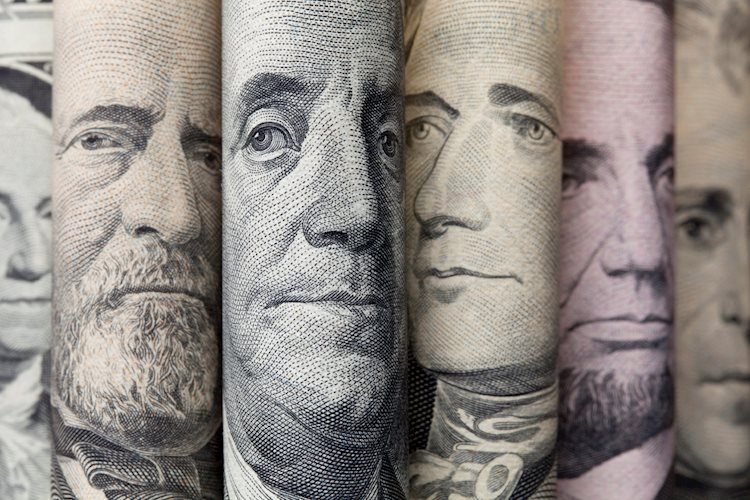- The US Dollar Index gains traction around 100.65 in Friday’s Asian session.
- US Durable Goods Orders remained flat in August; US economy grew at an annual rate of 3.0% in Q2.
- The dovish tone of the US Fed continues to weigh on the Greenback.
The US Dollar Index (DXY) rebounds to near 100.65 during the Asian trading hours on Friday. The expectation that the Federal Reserve (Fed) will lower its borrowing costs in the future continues to undermine the USD broadly.
The Fed decided to cut interest rates last week by half a percentage point. Fed Chair Jerome Powell noted that the 50 basis points (bps) reduction was a “recalibration” of rates aimed at maintaining strength in the labor market while inflation moves sustainably to the Fed’s 2% goal.
Fed officials expect to cut interest rates more in the months to come, but they are not on a preset path. This, in turn, might drag the DXY lower in the near term. The markets are now pricing in nearly a 48.8% chance for another outsized half-percentage-point cut, while the odds of 25 bps stand at 51.2%, according to CME Group’s FedWatch Tool.
The upbeat US economic data on Thursday provided some support to the Greenback, but a rally faded as traders shifted the focus to the US inflation data, which is due later on Friday. Analysts estimate the headline Personal Consumption Expenditures (PCE) Price Index to rise 2.3% YoY in August and the core PCE to jump 2.7% YoY in the same period.
Data released by the US Census Bureau revealed that US Durable Goods Orders were unchanged in August versus 9.9% prior, above the market consensus of 2.6%. Meanwhile, the final US Gross Domestic Product (GDP) rose at an annual rate of 3.0% in the second quarter (Q2), as previously estimated.
Fed Governor Lisa Cook said on Thursday that she endorsed the 50 bps interest rate cut last week as a way to address increased “downside risks” to employment. Fed Governor Adriana Kugler stuck to the Fed’s dovish tone, saying “I strongly supported the decision last week by the Federal Open Market Committee (FOMC) to cut the federal funds rate by 50 basis points…If conditions continue to evolve in the direction traveled thus far, then additional cuts will be appropriate.” The dovish stance of the US central bank contributes to the US Dollar Index’s downside.
US Dollar FAQs
The US Dollar (USD) is the official currency of the United States of America, and the ‘de facto’ currency of a significant number of other countries where it is found in circulation alongside local notes. It is the most heavily traded currency in the world, accounting for over 88% of all global foreign exchange turnover, or an average of $6.6 trillion in transactions per day, according to data from 2022. Following the second world war, the USD took over from the British Pound as the world’s reserve currency. For most of its history, the US Dollar was backed by Gold, until the Bretton Woods Agreement in 1971 when the Gold Standard went away.
The most important single factor impacting on the value of the US Dollar is monetary policy, which is shaped by the Federal Reserve (Fed). The Fed has two mandates: to achieve price stability (control inflation) and foster full employment. Its primary tool to achieve these two goals is by adjusting interest rates. When prices are rising too quickly and inflation is above the Fed’s 2% target, the Fed will raise rates, which helps the USD value. When inflation falls below 2% or the Unemployment Rate is too high, the Fed may lower interest rates, which weighs on the Greenback.
In extreme situations, the Federal Reserve can also print more Dollars and enact quantitative easing (QE). QE is the process by which the Fed substantially increases the flow of credit in a stuck financial system. It is a non-standard policy measure used when credit has dried up because banks will not lend to each other (out of the fear of counterparty default). It is a last resort when simply lowering interest rates is unlikely to achieve the necessary result. It was the Fed’s weapon of choice to combat the credit crunch that occurred during the Great Financial Crisis in 2008. It involves the Fed printing more Dollars and using them to buy US government bonds predominantly from financial institutions. QE usually leads to a weaker US Dollar.
Quantitative tightening (QT) is the reverse process whereby the Federal Reserve stops buying bonds from financial institutions and does not reinvest the principal from the bonds it holds maturing in new purchases. It is usually positive for the US Dollar.
Read the full article here

